Full-fat cream cheese made at home with just 3 ingredients.
Smooth and creamy with a slight tang to it, your cheese spread can be made with just a jug of full-fat (whole)milk, lime or vinegar, and salt.
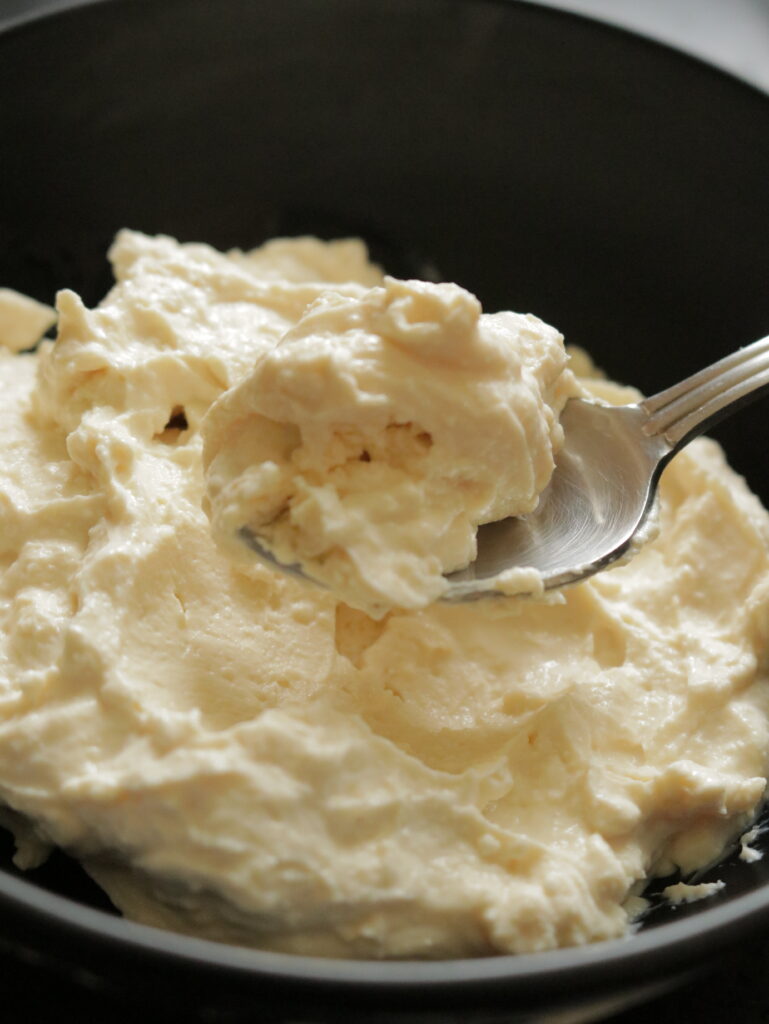
Making cream cheese at home.
We’ve been making our cream cheese for some time now.
Having kids who love cheese spread and looking at the soaring prices of store-bought cream cheese, it’s just practical to make it at home.
If you are making it for the first time, the whole process will take you an hour but once you’ve made the cheese spread a few times, you can make it within 30 minutes.
You’ll never go back to buying store-bought cream cheese spread ever again.
How to use the cream cheese.
Slather over toasted bread, bagels and buns, and top it off with an egg omelette or scrambled eggs to make a quick breakfast.
When making pasta, you can add creaminess to the pasta dish by mixing cream cheese.
Whip up your cream cheese and make some easy dips.
Add a layer of cream cheese to your sandwiches.
Homemade cream cheese Vs store-bought.
Honestly, there isn’t much of a difference except the saltiness and texture.
And these elements can only be improved as you make each batch of cream cheese and experiment as you go along.
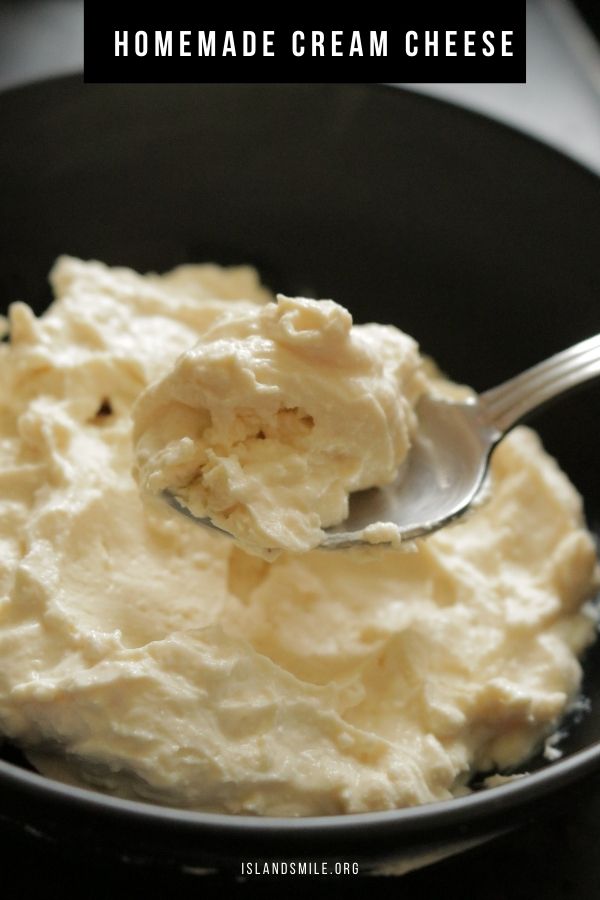
Tips on making cream cheese.
- Having all the prep work and ingredients ready will help the making cheese process seamless.
- You need whole milk(full-fat milk) to make cheese, non-fat won’t work.
- The amount of salt you add can impact the taste of your cream cheese.
- We used lime juice to curdle the milk, you can substitute it with lemon or vinegar. if you use vinegar, you need to be careful about the quantity as it affects the taste.
- Strong vinegar can leave an aftersmell on your cheese, use light white vinegar.
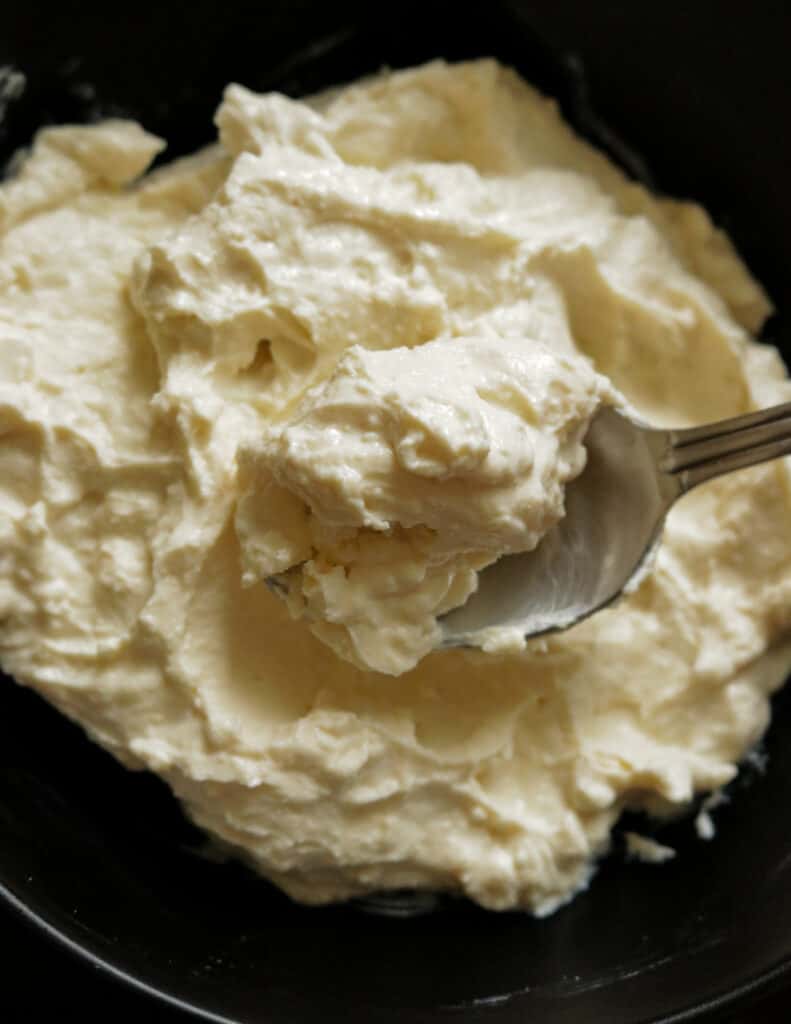
FAQ: for full-fat cream cheese.
- How to store homemade cream cheese.
- Make sure the container you choose to store the cream cheese is completely dry. Once you fill the bottle with the cheese, close the lid tight and refrigerate. Always use a dry spoon.
- How long will the cream cheese last?
- As there are no preservatives and you’ll probably be using pasteurized milk, I would recommend using the cream cheese within a week.
More useful homemade recipes.
ginger garlic paste recipe(5-steps, DIY).
How to make pickled Garlic (DIY recipe)
Sri Lankan three spice-raw/unroasted curry powder(thuna-paha).
how to make ground cumin powder.
how to make coriander powder and how to use it.
RECIPE DIFFICULTY- LITTLE CARE NEEDED
Utensils and appliances needed.
- Heavy-bottomed medium-sized pan to heat the milk.
- A colander or large sieve to strain the milk curd.
- Cheesecloth (I’ve mentioned a few substitutes to use instead of cheesecloth, I have mentioned a few materials on the recipe instructions below).
- A pan to collect the whey water
- Blender (use the smaller blender cup) or food processor
- Glass container to store the cheese
Ingredients to make full-fat cream cheese
The ingredients mentioned below use standard measuring cups and spoons.
1 litre (4 cups)of full-fat milk(also known as whole milk)
2 tablespoons of lime(substitute with lemon or white vinegar, make sure the vinegar has a strong smell).
Salt to use as needed(start with 1/2 a teaspoon, taste and adjust).
Herbs, such as garlic are optional ingredients to flavour the cheese.
How to make cream cheese
Prep work to make the cheese.
Have a dry empty bottle ready to store the cheese.
Place the straining cheesecloth(substitute materials mentioned below)over a colander or large sieve.
Place this over a pan to collect the whey liquid.
Substituting cheesecloth, if you are unable to find a cheesecloth, use a material that will strain and separate the whey from the milk curd.
I tried a piece of stretchable material which worked well too.
Make sure the material is large enough to cover the sieve or colander and then grip and squeeze out the whey comfortably.
Some other substitutes for cheesecloth are white linen(handkerchief material, not a handkerchief as it will not be big enough), a fine mesh bag, muslin, a clean and new cotton dish towel or a tightly woven mesh strainer.
Have the ingredients to make cream cheese ready.
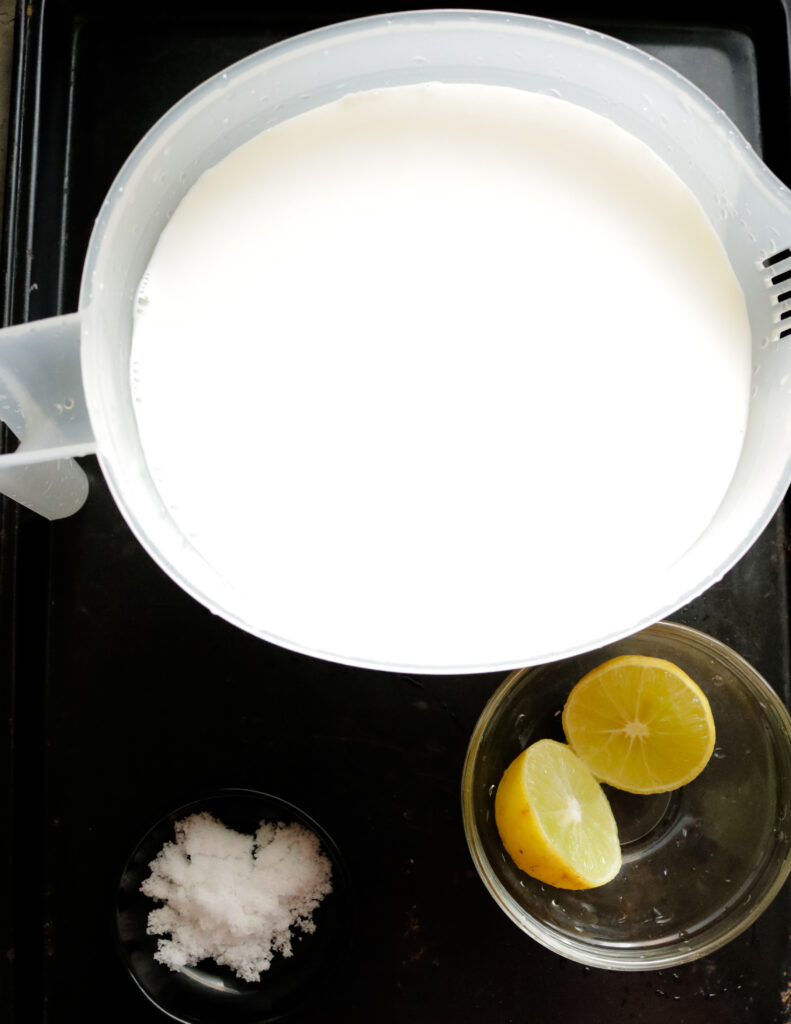
Add the milk into a heavy-bottomed pan and heat the milk over low-medium heat.
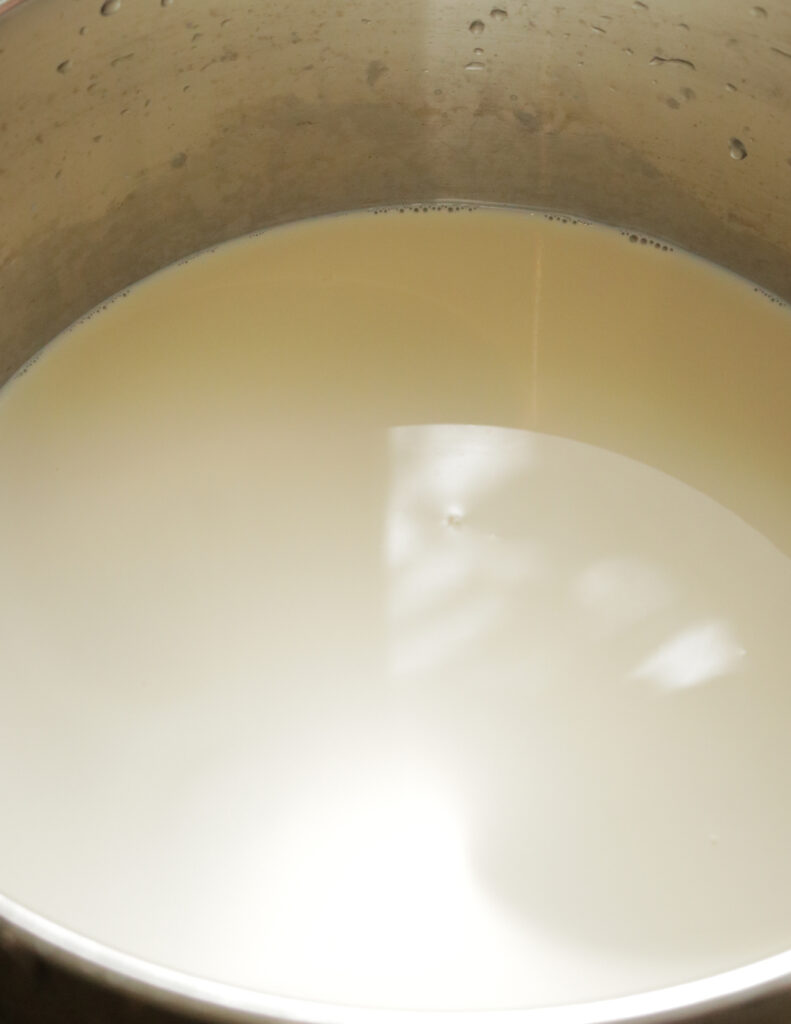
Frequently stir the milk and bring it to a high simmer(not to a rolling boil).
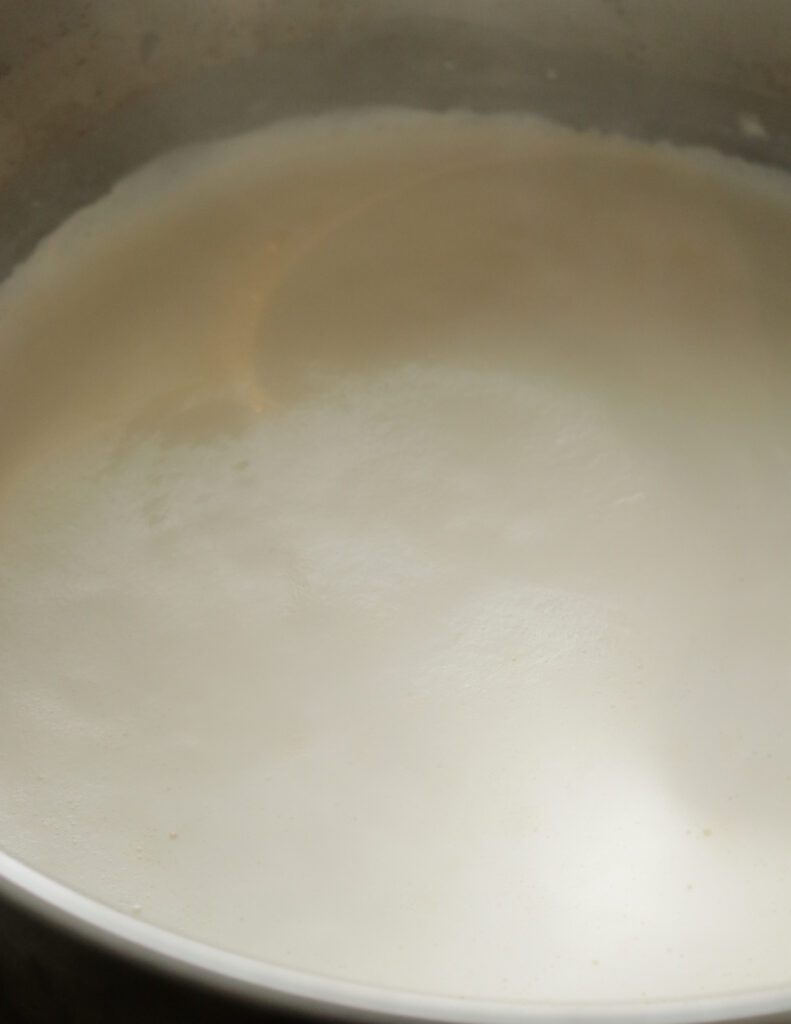
Reduce heat to low and pour in the lime juice(2 tbsp).
Continue stirring.
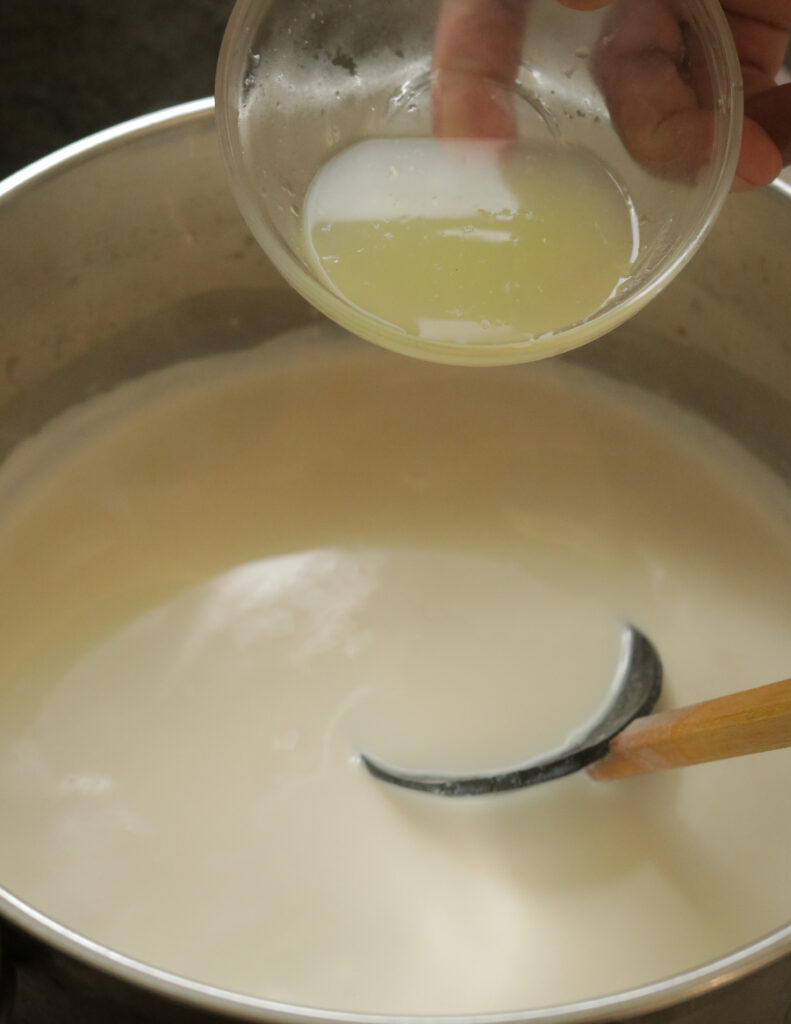
You’ll notice the milk curdling.
Further, reduce heat to low and stir gently to help the curdling.
Stage 1 of curdling.
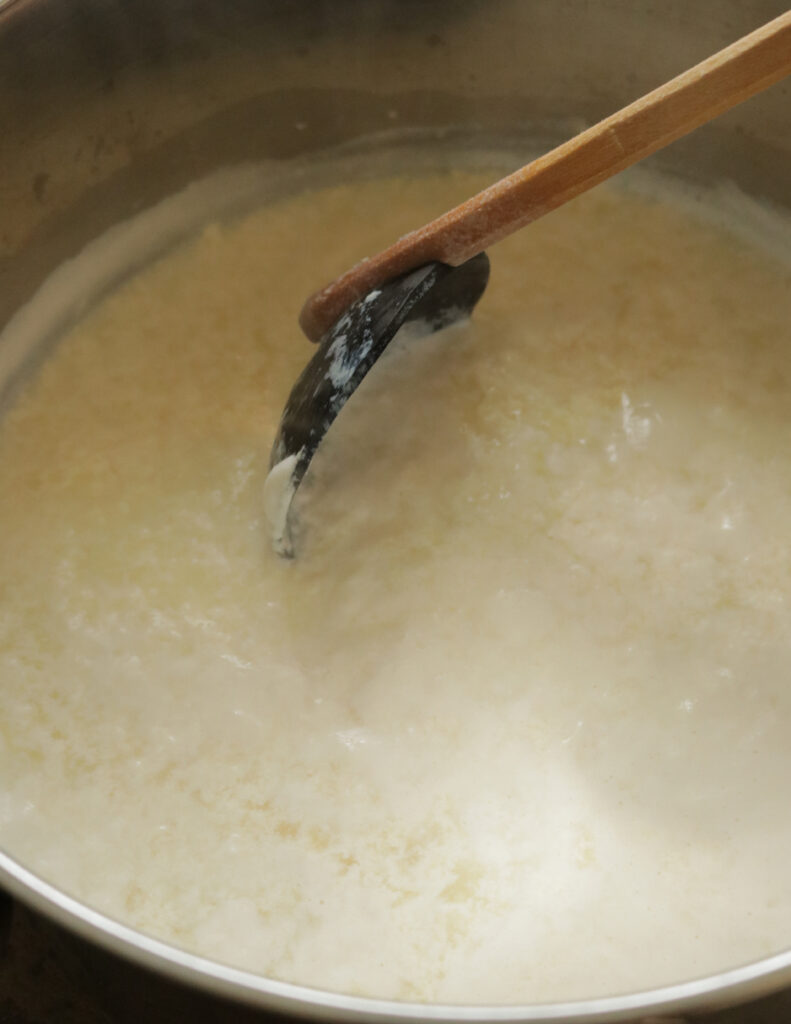
Stage 2 of curdling after a few seconds.
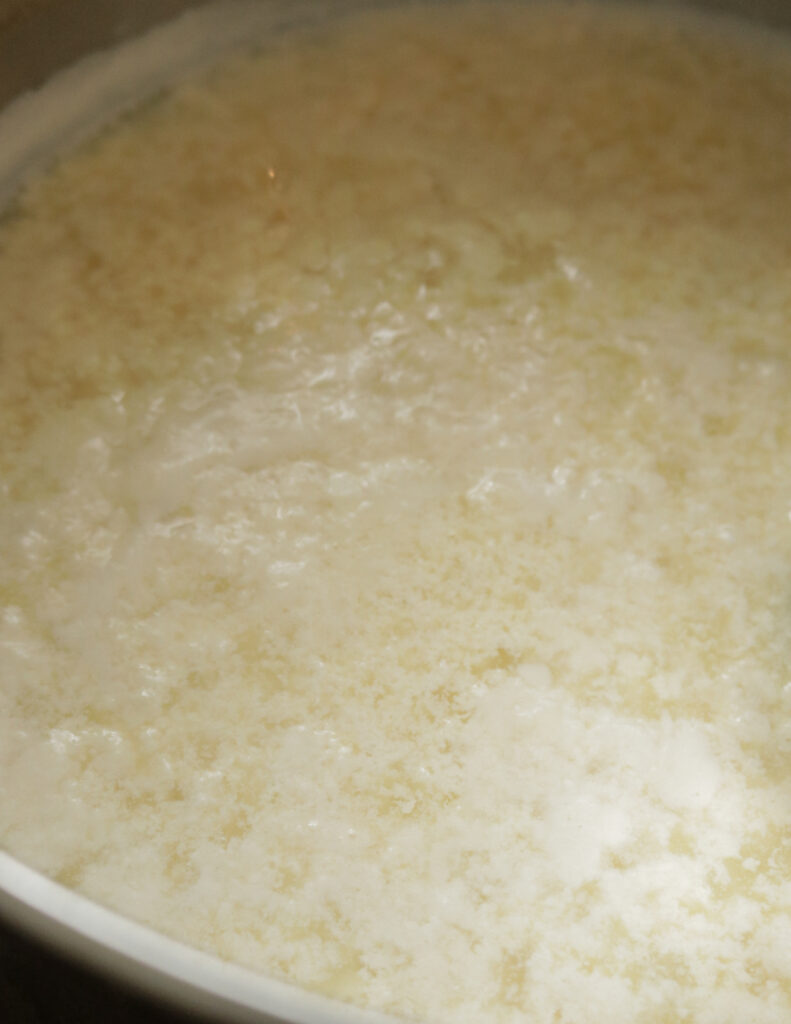
Stage 3 of curdling where you will see the whey separating from the milk curd.
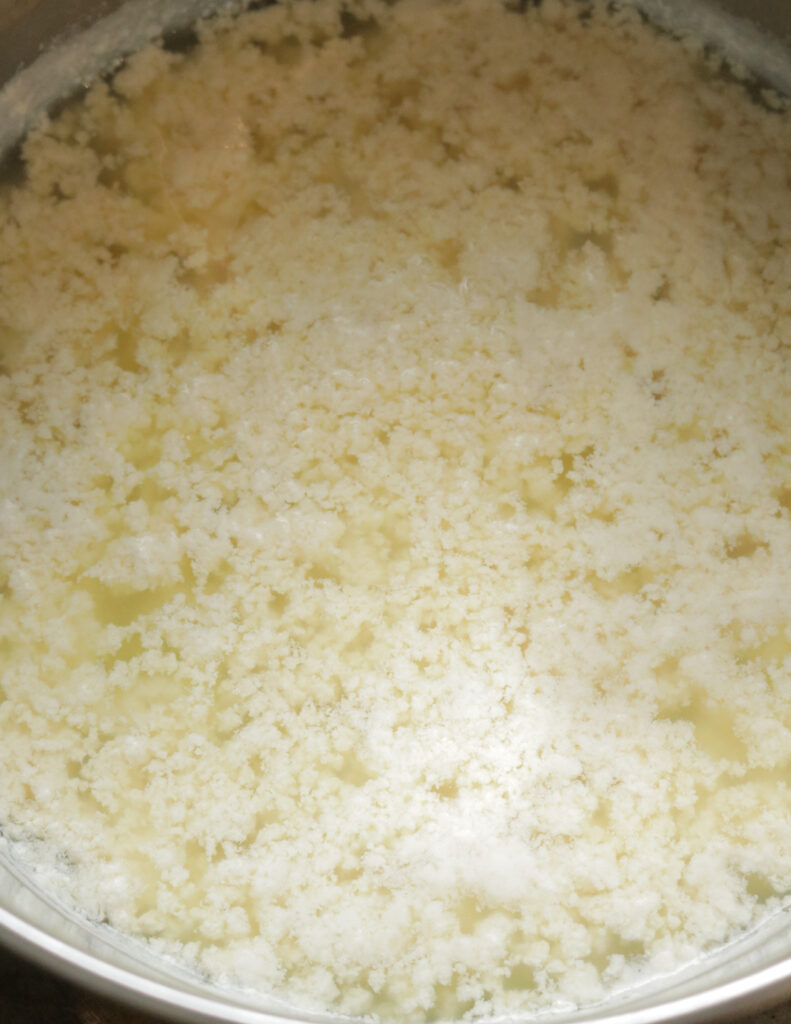
Remove the pan and pour the milk curd into the sieve.
Warning- the liquid and milk curd is hot, pour gently to avoid splashing.
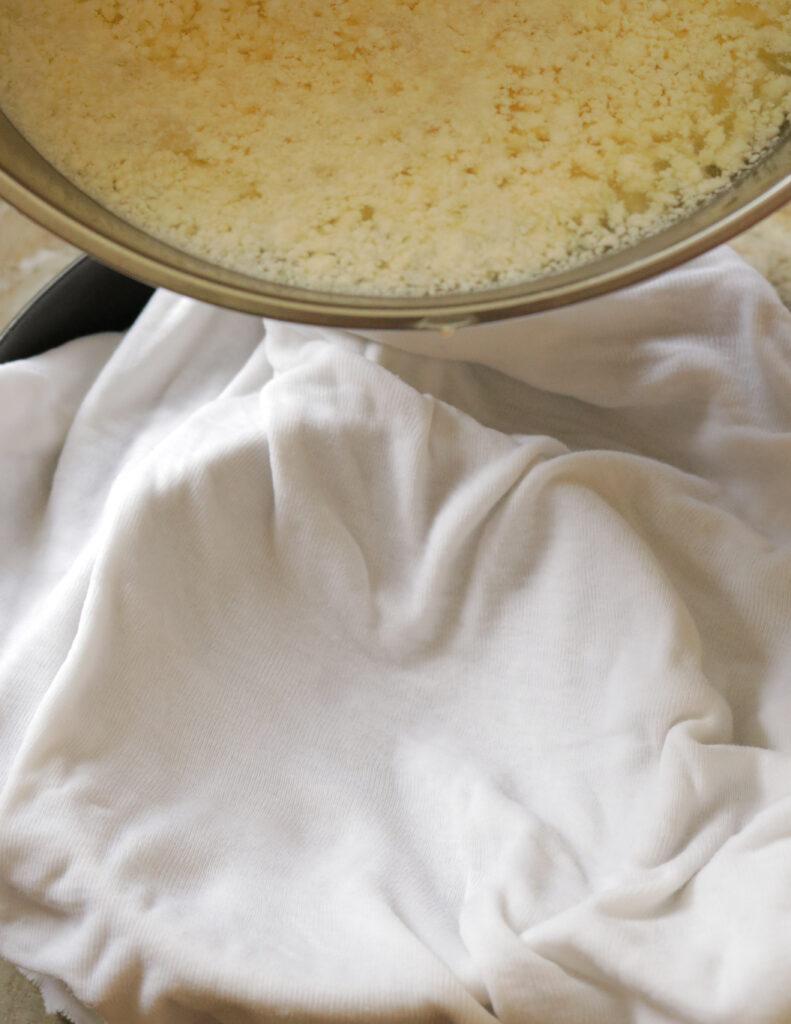
Gradually pour the milk curd onto the cheesecloth to strain.
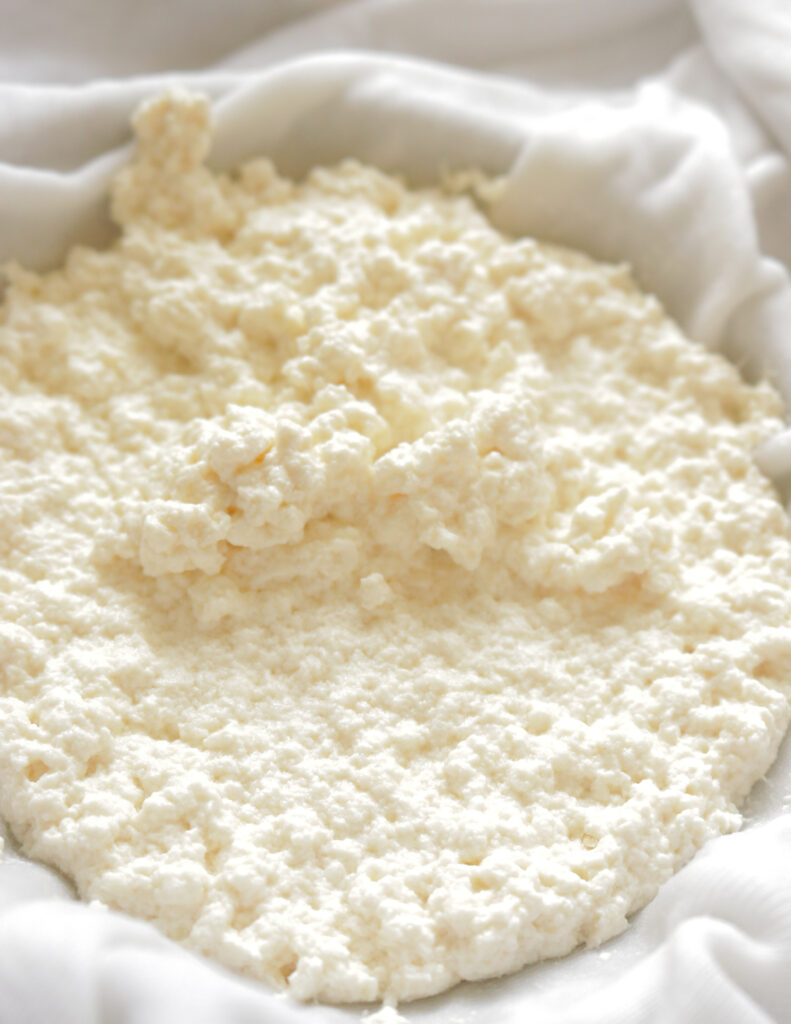
Cover with the edges of the straining cloth and let the milk rest for 5 minutes.
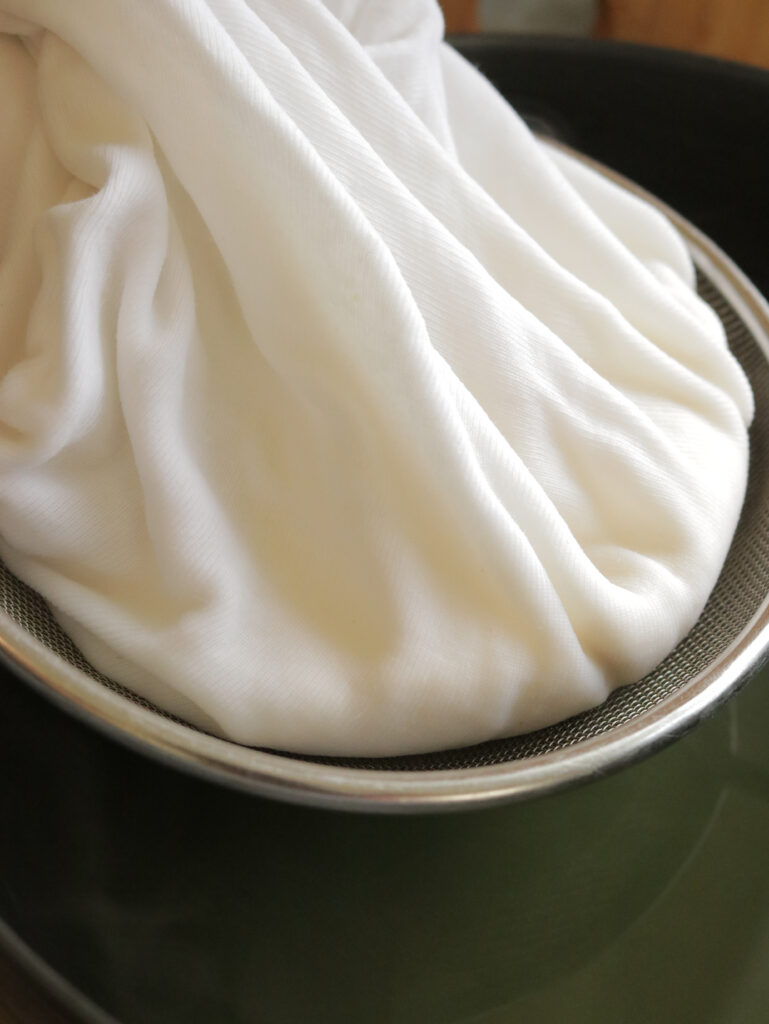
Gather the material and let the milk curd bundle hang over the pan.
DO NOT THROW AWAY THE WHEY WATER.
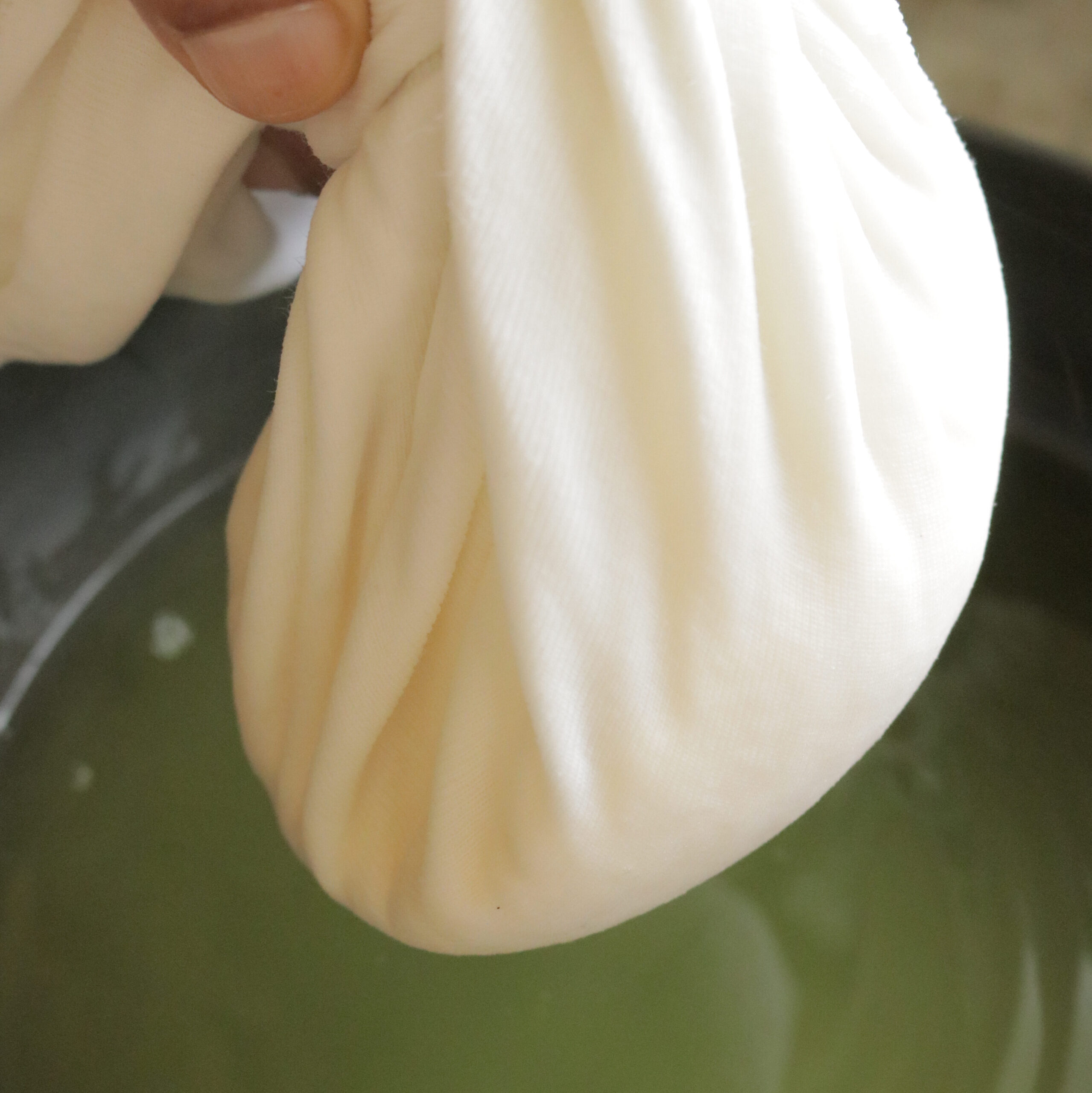
Twist and gently squeeze the excess whey water.
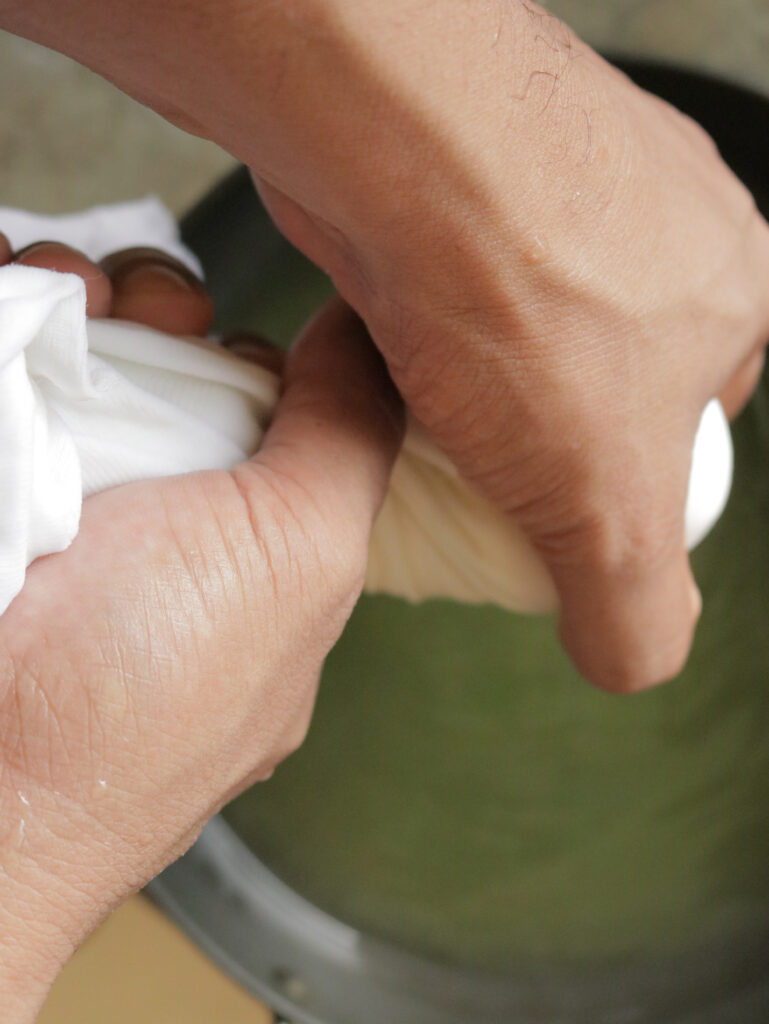
Place the bundle in a bowl and remove the cloth from the milk curd ball.
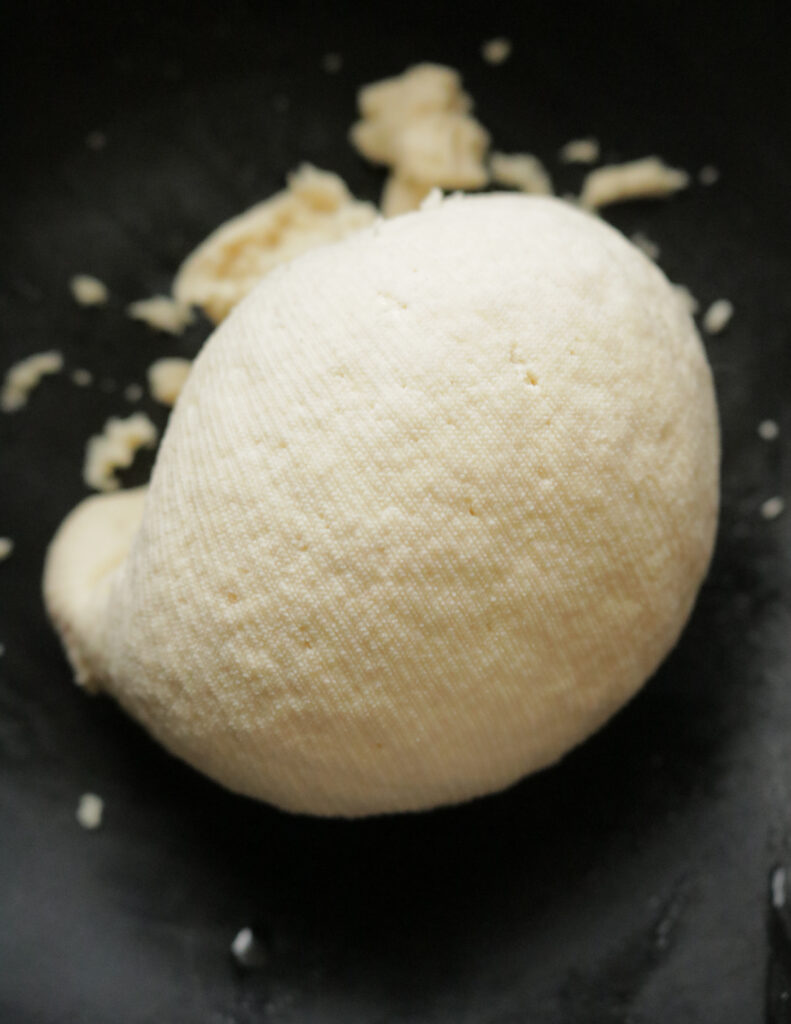
Crumble the curd with a spoon.
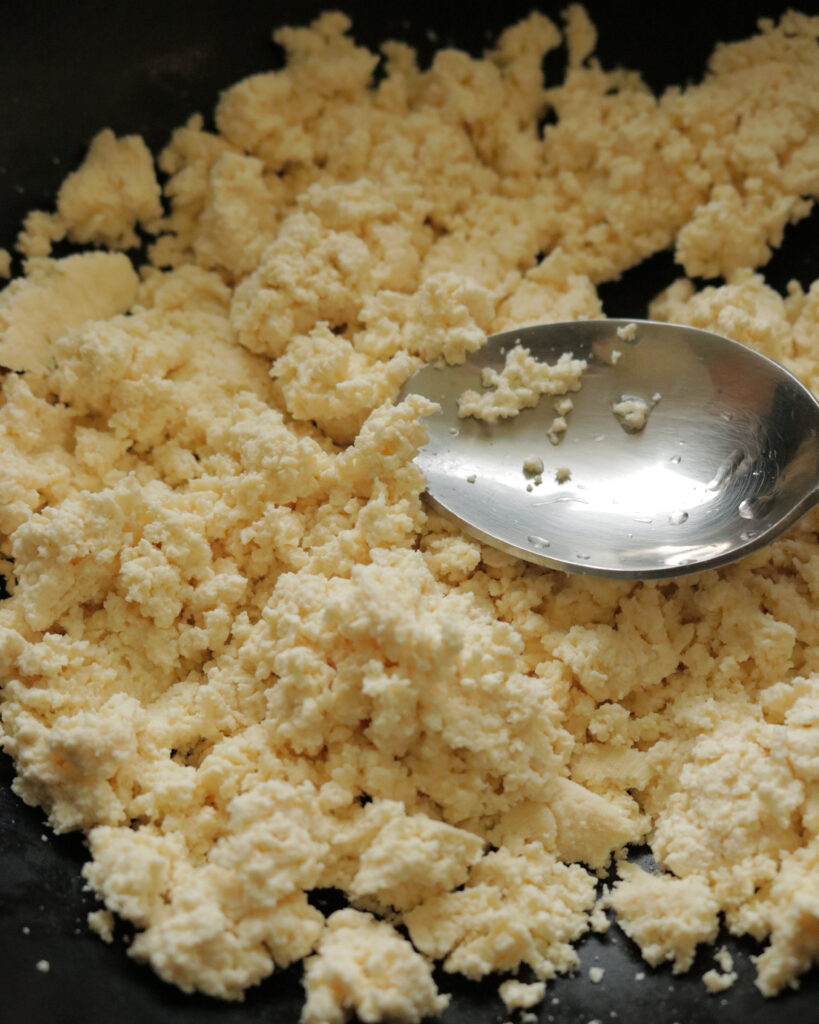
Add salt, start with 1/2 a teaspoon and add more as you need later.
For this batch I added 1 teaspoon which made the cheese a little too salty, so be careful with the salt.
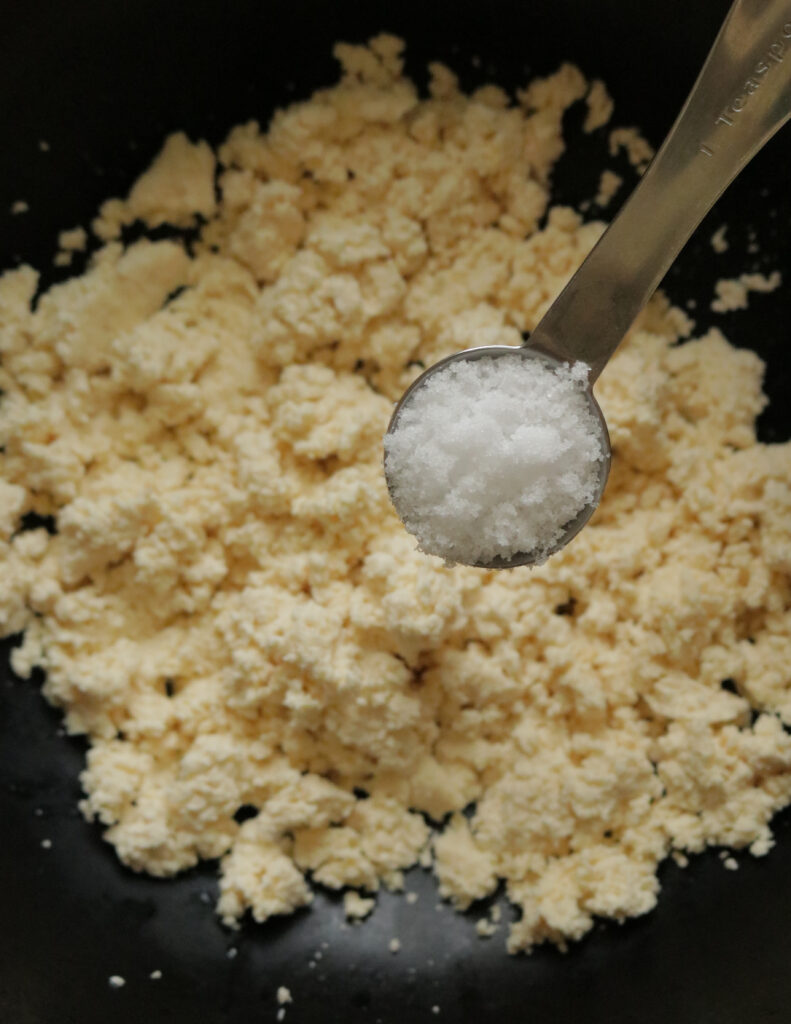
Transfer the curd to a food processor.
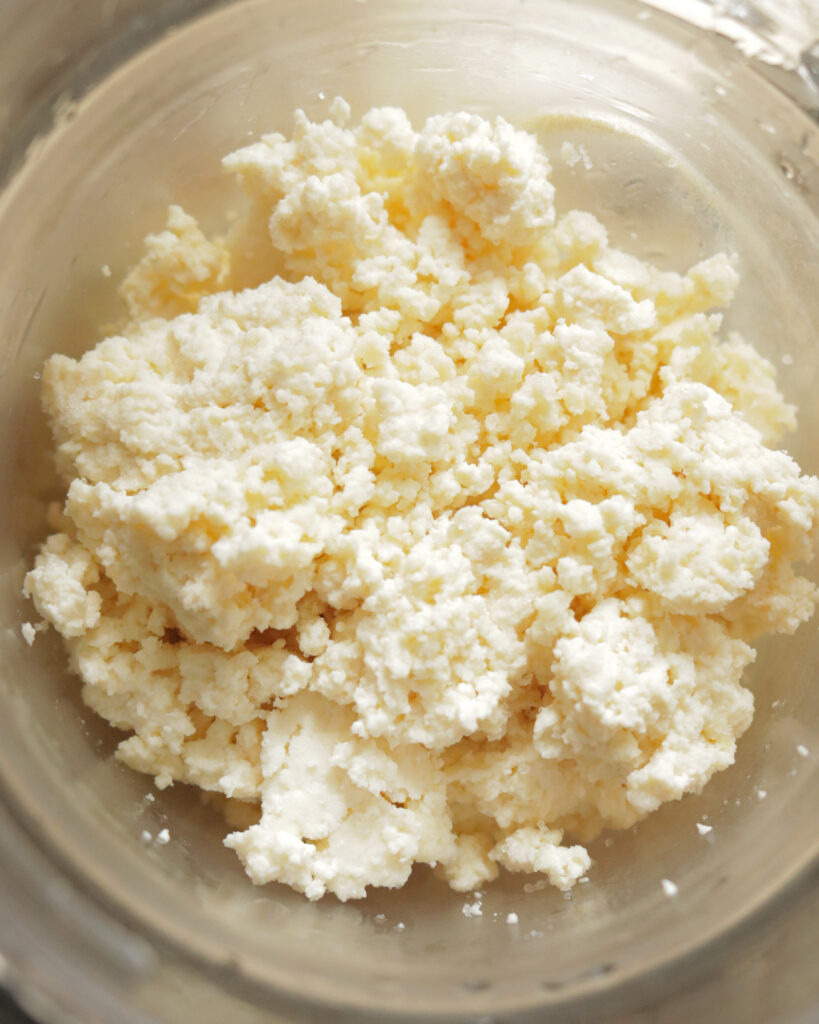
Add 2 tablespoons of the whey water and pulse until the cheese is slightly smooth. At least a minute.
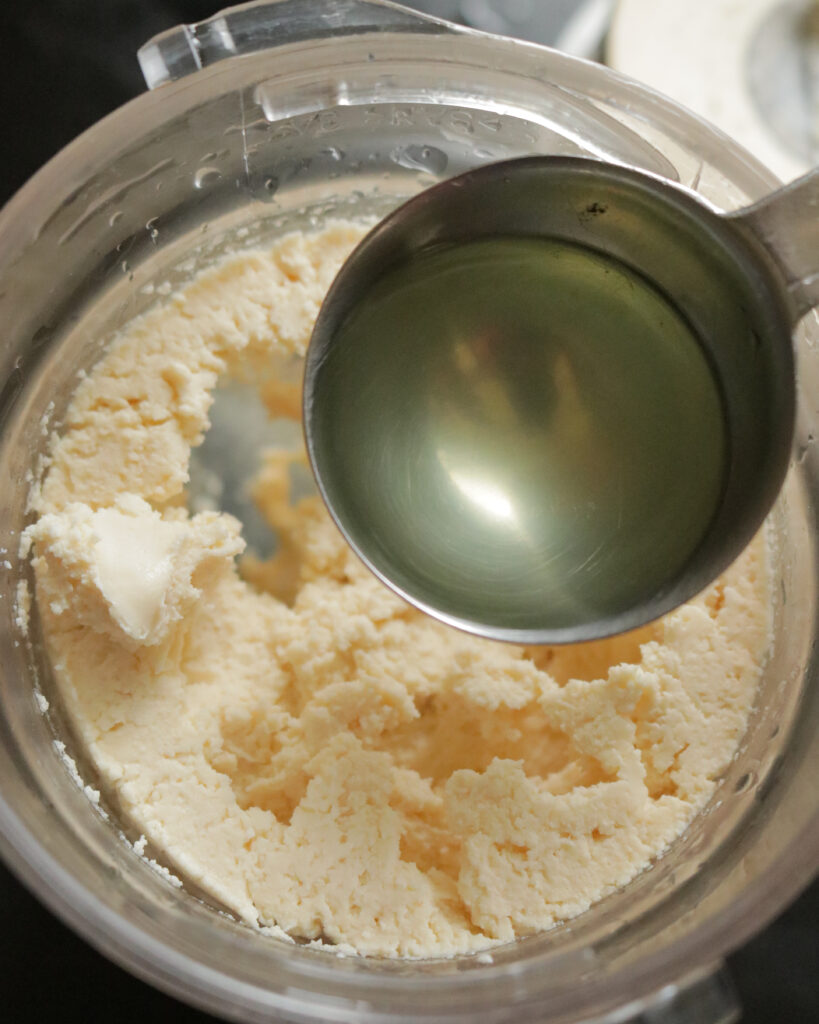
Stage 1.
Cream cheese is still grainy.
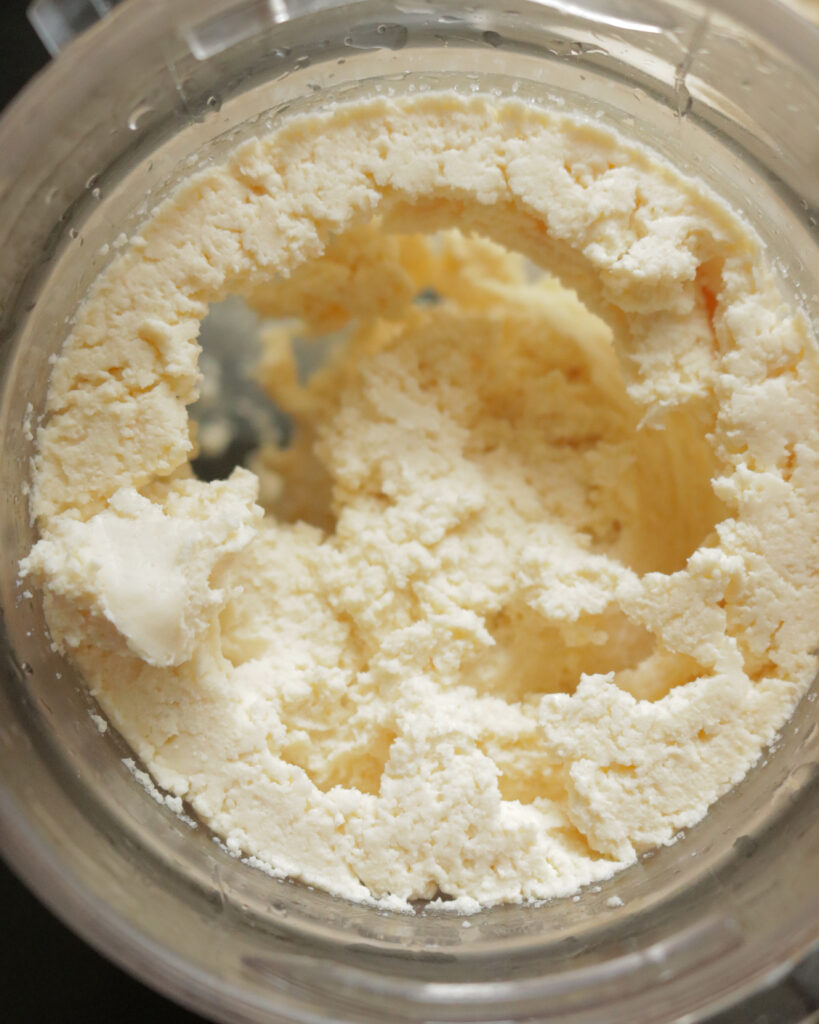
2nd Stage of the cheese texture.
Add 1 tablespoon of whey and blend for a minute.
Check the texture and taste of the cream cheese.
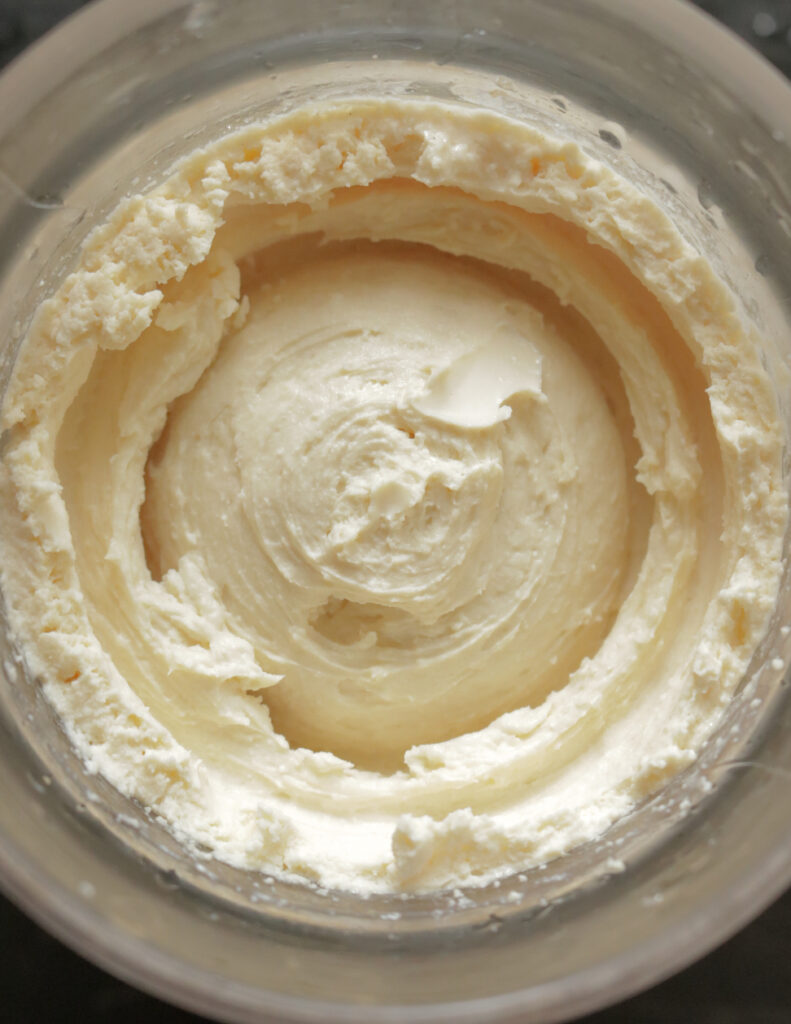
Continue to work on the cream cheese texture and taste by adding whey and salt to reach the correct creamy consistency.
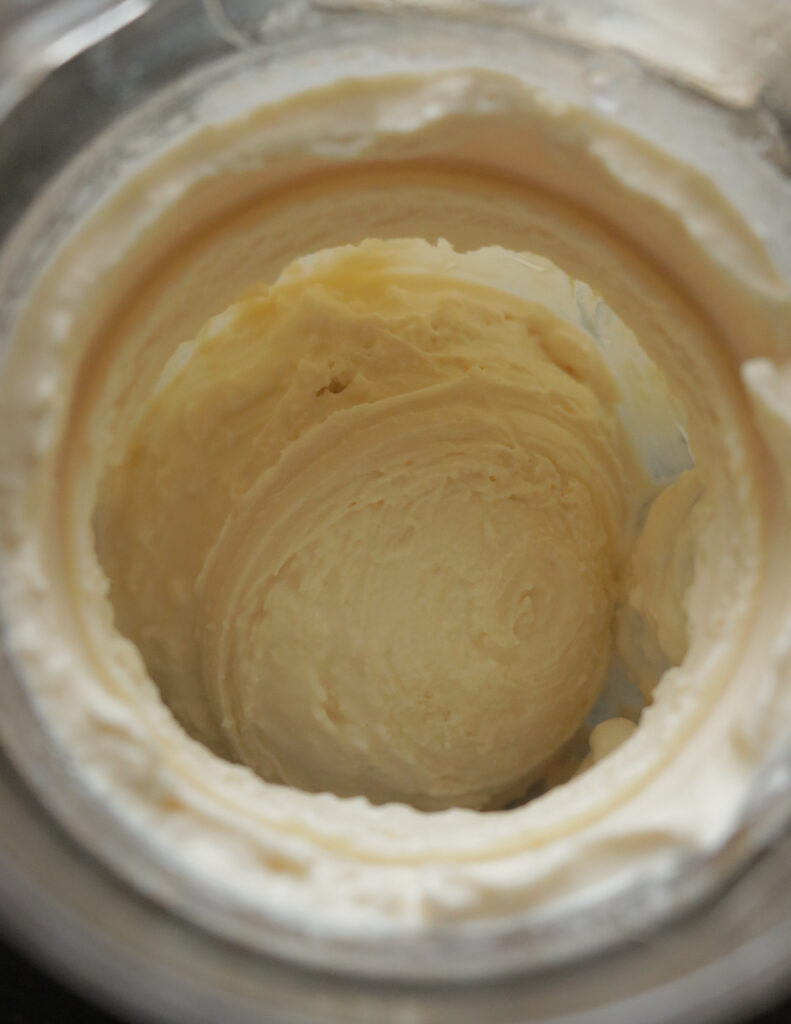
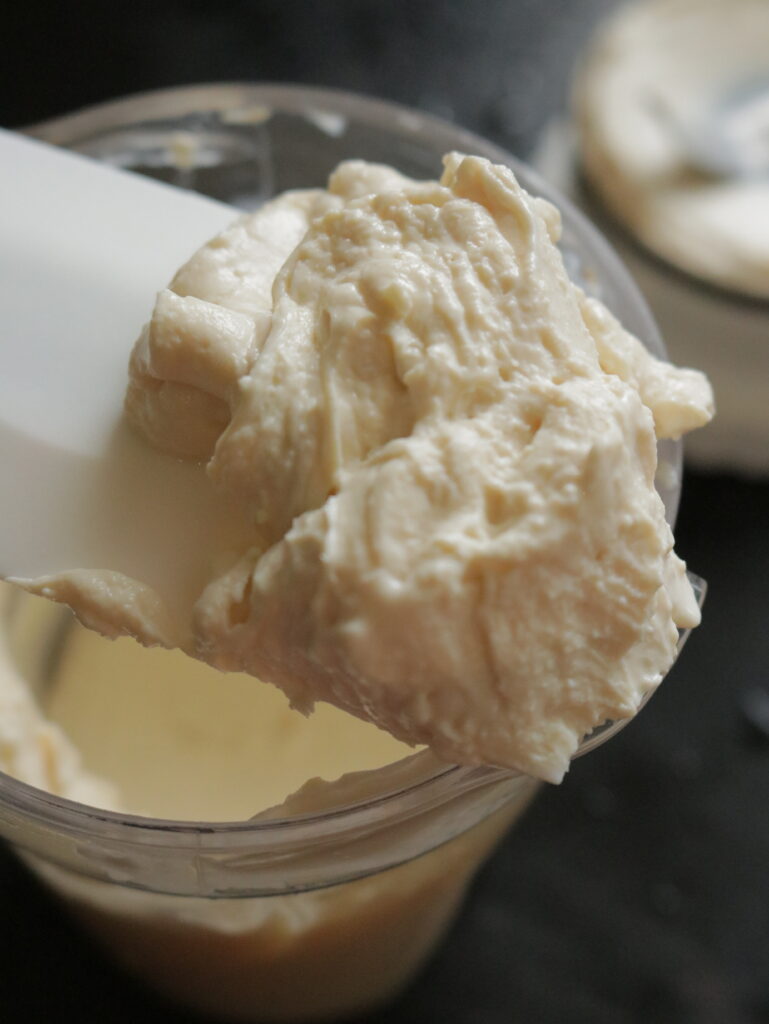
Once the cream cheese is done store it in a glass container.
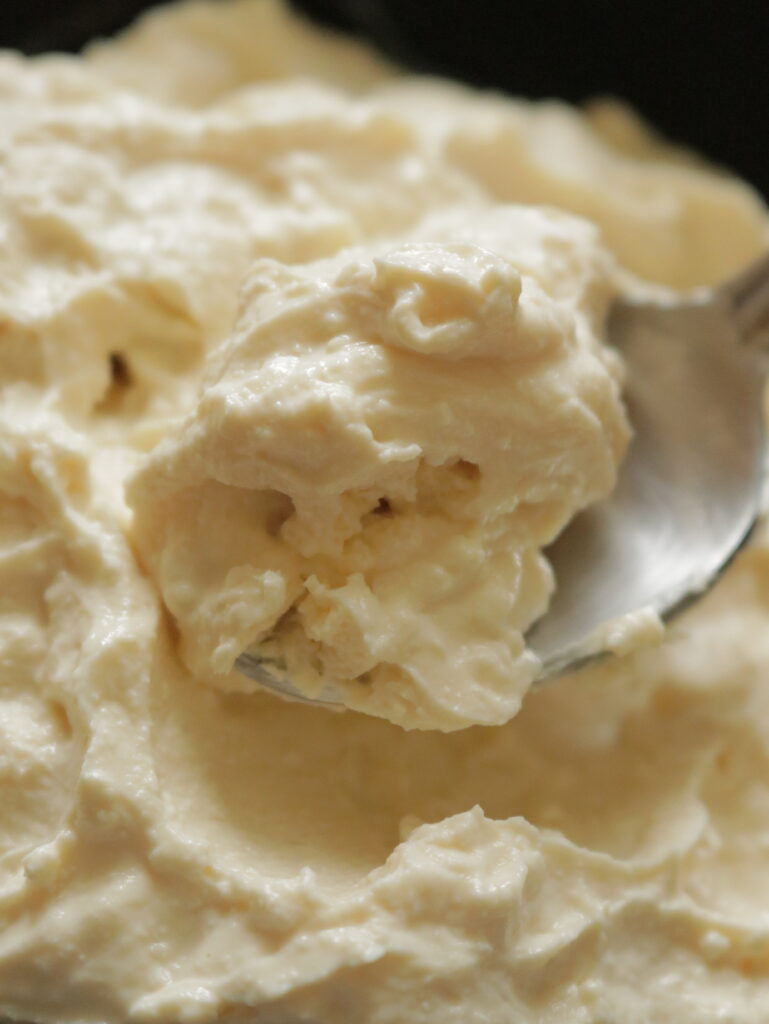
JOIN ME ON ISLANDSMILE YOUTUBE CHANNEL
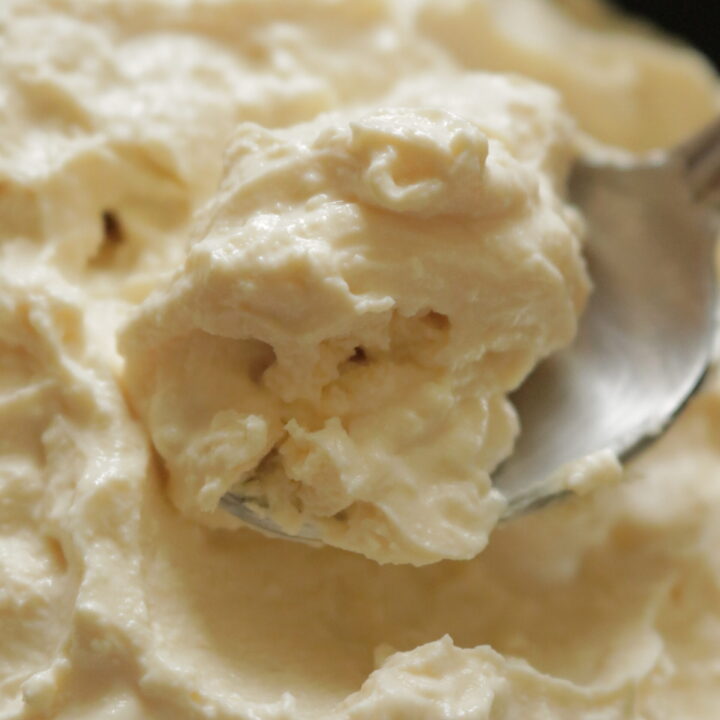
Homemade cream cheese.
Homemade cream cheese with just 3 ingredients.
If you’ve ever wanted to make cream cheese and wondered how you can make it at home, then this cream cheese recipe is for you.
Ingredients
- 1 liter (4 cups)of full-fat milk(also known as whole milk)
- 2 tablespoons of lime(substitute with lemon or white vinegar, make sure the vinegar has a strong smell)
- Salt to use as needed(start with 1/2 a teaspoon, taste and adjust)
- Herbs, such as garlic are optional ingredients to flavor the cheese.
Instructions
Prep work to make the cheese.
- Have a dry empty bottle ready to store the cheese.
- Place the straining cheesecloth(substitute materials mentioned below)over a colander or large sieve. Place this over a pan to collect the whey liquid.
- Substituting cheesecloth, if you are unable to find a cheesecloth, use a material that will strain and separate the whey from the milk curd. I tried a piece of stretchable material which worked well too.
- Make sure the material is large enough to cover the sieve or colander and then grip and squeeze out the whey comfortably.
- Some other substitutes for cheesecloth are white linen(handkerchief material, not a handkerchief as it will not be big enough), a fine mesh bag, muslin, a clean and new cotton dish towel or a tightly woven mesh strainer.
- Have the ingredients to make cream cheese ready.
- Add the milk into a heavy-bottomed pan and heat the milk over low-medium heat.
- Frequently stir the milk and bring it to a high simmer(not to a rolling boil).
- Reduce heat to low and pour in the lime juice(2 tbsp).
- Continue stirring.
- You’ll notice the milk curdling.
- Further, reduce heat to low and stir gently to help the curdling.
Stage 1 of curdling.
- Stage 2 of curdling after a few seconds
- Stage 3 of curdling where you will clearly see the whey separating from the milk curd.
- Remove the pan and pour the milk curd into the sieve.
- Warning- the liquid and milk curd is hot, pour gently to avoid splashing.
- Gradually pour the milk curd onto the cheesecloth to strain.
- Cover with the edges of the straining cloth and let the milk rest for 5 minutes.
- Gather the material and let the milk curd bundle hang over the pan.
- DO NOT THROW AWAY THE WHEY WATER.
- Twist and gently squeeze the excess whey water.
- Place the bundle in a bowl and remove the cloth from the milk curd ball.
- Crumble the curd with a spoon.
- Add salt, start with 1/2 a teaspoon and add more as you need later. for this batch I added 1 teaspoon which made the cheese a little too salty, so be careful with the salt.
- Transfer the curd into a food processor.
- Add 2 tablespoons of the whey water and pulse until the cheese is slightly smooth. At least a minute.
- Stage 1.
- Cream cheese is still grainy.
2nd Stage of the cheese texture.
- Add 1 tablespoon of whey and blend for a minute.
- Check the texture and taste of the cream cheese.
- Continue to work on the cream cheese texture and taste by adding whey and salt to reach the correct creamy consistency.
- Once the cream cheese is done store it in a glass container.
Recommended Products
As an Amazon Associate and member of other affiliate programs, I earn from qualifying purchases.
-
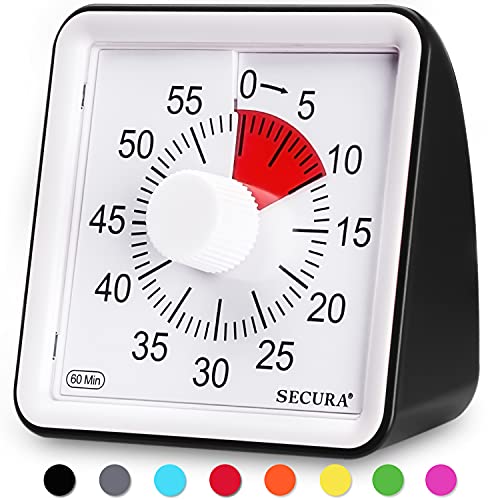 Secura 60-Minute Visual Timer, Classroom Countdown Clock, Silent Timer for Kids and Adults, Time Management Tool for Teaching (Black)
Secura 60-Minute Visual Timer, Classroom Countdown Clock, Silent Timer for Kids and Adults, Time Management Tool for Teaching (Black) -
 Kitchen Shears, iBayam Kitchen Scissors Heavy Duty Meat Scissors Poultry Shears, Dishwasher Safe Food Cooking Scissors All Purpose Stainless Steel Utility Scissors, 2-Pack (Black Red, Black Gray)
Kitchen Shears, iBayam Kitchen Scissors Heavy Duty Meat Scissors Poultry Shears, Dishwasher Safe Food Cooking Scissors All Purpose Stainless Steel Utility Scissors, 2-Pack (Black Red, Black Gray) -
 Hudson Essentials Stainless Steel Measuring Cups Set - 6 Piece Stackable Set with Spout
Hudson Essentials Stainless Steel Measuring Cups Set - 6 Piece Stackable Set with Spout -
 Pyrex Glass Measuring Cup Set (3-Piece, Microwave and Oven Safe),Clear
Pyrex Glass Measuring Cup Set (3-Piece, Microwave and Oven Safe),Clear -
 Spring Chef Magnetic Measuring Spoons Set, Dual Sided, Stainless Steel, Fits in Spice Jars, Black, Set of 8
Spring Chef Magnetic Measuring Spoons Set, Dual Sided, Stainless Steel, Fits in Spice Jars, Black, Set of 8 -
 Zulay 3 Cup Stainless Steel Flour Sifter - Fine Mesh Rotary Hand Crank Flour Sifter with Agitator Wire Loop For Baking Cakes, Pastries, Pies, Cupcakes and Desserts
Zulay 3 Cup Stainless Steel Flour Sifter - Fine Mesh Rotary Hand Crank Flour Sifter with Agitator Wire Loop For Baking Cakes, Pastries, Pies, Cupcakes and Desserts -
 Pyrex Prepware 1-1/2-Quart Glass Mixing Bowl
Pyrex Prepware 1-1/2-Quart Glass Mixing Bowl -
 Instant Pot Duo 7-in-1 Electric Pressure Cooker, Slow Cooker, Rice Cooker, Steamer, Sauté, Yogurt Maker, Warmer & Sterilizer, Includes Free App with over 1900 Recipes, Stainless Steel, 3 Quart
Instant Pot Duo 7-in-1 Electric Pressure Cooker, Slow Cooker, Rice Cooker, Steamer, Sauté, Yogurt Maker, Warmer & Sterilizer, Includes Free App with over 1900 Recipes, Stainless Steel, 3 Quart -
 KITCHENDAO Lemon Zester Bar Tool 4 in 1, Citrus Lime Zester Peeler, Channel Knife, Citrus Reamer, Grater, Seed Pip Catcher to Avoid Mess, Soft-Touch Grip, Compact for Easy Storage, Dishwasher Safe
KITCHENDAO Lemon Zester Bar Tool 4 in 1, Citrus Lime Zester Peeler, Channel Knife, Citrus Reamer, Grater, Seed Pip Catcher to Avoid Mess, Soft-Touch Grip, Compact for Easy Storage, Dishwasher Safe
Nutrition Information:
Yield: 5 Serving Size: 1Amount Per Serving: Calories: 51Total Fat: 3gSaturated Fat: 2gTrans Fat: 0gUnsaturated Fat: 1gCholesterol: 9mgSodium: 177mgCarbohydrates: 3gFiber: 0gSugar: 3gProtein: 3g
Nutrition facts are an estimate and not guaranteed to be accurate. Please see a registered dietitian for special diet advice.
With you in mind, each recipe on this blog has been written with great care and love to the best of my ability.
It’s free and on the blog, for you to try anytime.
All I ask is that you do not save it on any apps, recipe boxes or online groups which will affect me as a food blogger and the growth of this blog.
I would appreciate it if you only share the link rather than the full recipe.